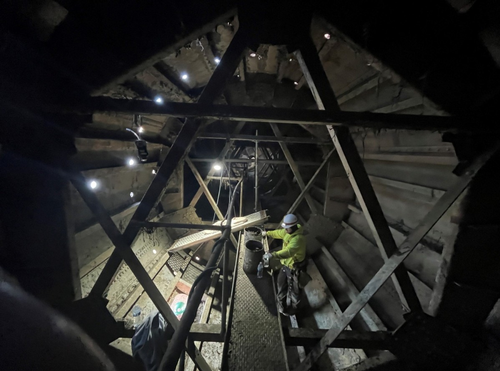Painting Underway for Lock, Dam Rehab Project
WEDNESDAY, DECEMBER 18, 2024
The U.S. Army says they will be prioritizing safety and sustainability during a $40 million rehabilitation effort to improve locks and dams on the Upper Mississippi River. The projects will involve abrasive blasting, painting, rehabilitation and other maintenance of the roller gates at each lock and dam.
About the Project
According to a recent news release from the Army, work started at Lock and Dam 5 in Minnesota City, Minnesota, in March. As of November, work was underway on Lock and Dam 5A in Fountain City, Wisconsin. The Army explains that both sides will undergo “comparable” rehabilitation work over the next four construction seasons.
“By prioritizing safety and sustainability, the rehabilitation work not only seeks to mend the physical structures, but also provide intended benefits to the nation and protect the people who live near them,” said Billy Thomson, Project Manager.
At Lock and Dam 5A, work will involve rehabilitation of the roller gate bulkheads, tainter gate bulkheads and bulkhead storage carts, as well as installing corrosion protection on the roller gates. These gates will also be repainted grey.
“One of the notable aesthetic changes that the public will see throughout the projects is changing in the roller gate paint color from red to grey. The coating system is critical in providing durability for the damming surface,” Thomson said.
The previous gates were reportedly painted with V-106 red paint due to availability and affordability. However, suppliers have recently started phasing out production due to manufacturing concerns with the formation containing hazardous characteristics and pass/fail rate issues with hydraulic steel structure application.

 |
| U.S. Army |
|
The U.S. Army says they will be prioritizing safety and sustainability during a $40 million rehabilitation effort to improve locks and dams on the Upper Mississippi River. |
“A major project like this requires careful planning and coordination, encompassing essential elements such as thorough inspections, necessary repairs, fabrication of components, safe scaffolding design, debris removal and safety measures for abrasive blasting,” said Greg Hammons, Contracting Officer Representative. “Each of these components is critical to ensuring the project’s success and the long-term integrity of the infrastructure.”
“The last extensive painting of dam gates and service bridges were completed at Locks and Dams 4 and 6, in 2006,” said Mike Dahlquist, Operations Division, Engineering Support. “Since then, funding for similar projects has been scarce, although some routine gate maintenance was carried out through hired labor during lock dewatering projects, focusing on painting lock miter gates.
“This gap underscores the pressing need for investment in infrastructure maintenance, paving the way for the ongoing efforts to revitalize and protect these critical structures.”
Thomson explained that the U.S. Army Corps of Engineers' St. Paul District is working in a collaborative effort with the Corps' Rock Island and St. Louis districts.
“The district has leveraged the experiences of the Rock Island and St. Louis districts throughout design and construction, organizations who have also had recent gate maintenance, repair and replacement projects,” Thomson said. “Learning from others can lead to improved outcomes and cost savings.”
According to the Army, navigation remains uninterrupted at Lock and Dam 5, as dam repair work focuses solely on the components of the dam. Contractors worked through Nov. 15 to complete structural inspections and prepare a detailed repair plan for the second construction season.
The second season is reportedly expected to begin in spring 2025, with a focus on essential structural repairs to ensure the long-term stability and safety of the dam.
“These two projects are the first in a portfolio of work that will be ongoing on the river for years to come. The team is committed to using this opportunity to not only address issues now, but also best inform operation and maintenance decision making for future decades,” Thomson said.
Tagged categories: Health and safety; Infrastructure; Infrastructure; Locks and dams; Ongoing projects; Rehabilitation/Repair; Safety; Safety; Sandblasting; U.S. Army



